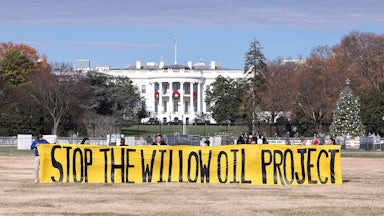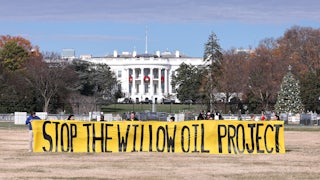In the last week, the Biden administration has elaborated on its shaky and ever-evolving approach to energy policy. At a confab for oil and gas executives last week, Cabinet members raised the possibility that fossil fuel CEOs could be “visionary leaders” in the fight against climate change. Days later, the administration handed the industry a giant bone: approving ConocoPhillips’s $8 billion Willow project in Alaska. At the same time, the administration announced it would close off an additional 16 million acres there to new drilling. No one seems especially happy about the White House’s tightrope walk on climate and energy. So who is the show for?
Climate activists, for their part, seem universally outraged about the president’s decision on Willow, a disavowal of his campaign trail pledge of “no more drilling on federal lands, period, period, period.”
But while the decision has angered environmentalists, it hasn’t won over their enemies either. Oil and gas executives are breathing a sigh of relief now that Democrats won’t pass bills that constrain their business model for the foreseeable future. They might even have a landmark Supreme Court ruling to look forward to in the not-too-distant future that dismantles agencies’ ability to do things like regulate carbon emissions by going after climate-related financial rules. None of that, however, has produced the sort of goodwill toward Democrats that might make oil execs cease funding Republican politicians, trade associations, and think tanks that are steadfastly committed to making sure that Democrats never govern again.
The administration landing on this ambiguous middle path makes sense considering, charitably, the constraints of the Democratic coalition. Voters of all stripes genuinely care about keeping gas prices low, especially when other essentials are subject to inflation too. If you think that there is a direct, causal link between the amount of oil drilling and exploration that happens in the United States and prices Americans pay at the pump (there isn’t), then you will want to encourage as much drilling as possible. If you simultaneously have a constituency of climate-concerned voters to satisfy, then while you will certainly make some choices that piss them off—like approving a gargantuan new Alaskan drilling project—you probably think you can still tell a win-win story. That story might be, for example, that reducing emissions will be the product of investing in new technologies and clean energy, not of reducing the amount of hydrocarbons that are dug up, traded, and burned. The White House may well feel that as long as it has done its bit to spur on new technologies and renewables through the Inflation Reduction Act, drilling can proceed apace or even be expanded as circumstances demand. Biden’s White House issued more permits for drilling on federal lands in its first 25 months than Donald Trump’s.
“We know that oil and gas will remain part of our energy mix for years to come,” Energy Secretary Jennifer Granholm told a crowd of energy executives last week, imploring them to adopt the White House’s view that “the clean energy transition is happening and that we are growing the energy pie.”
The problem with that win-win story is that it isn’t true. “Growing the energy pie,” i.e., increasing fossil fuels and increasing clean energy as well, means growing the emissions pie too. Fossil fuel production will need to be reduced long before it becomes unprofitable. Domestic fossil fuel production has a tenuous relationship, at best, to gas prices here given what sorts of fuels our refineries can process and high-seas commodity trading that few regulators on earth seem to understand (among other factors). Moreover, the Intergovernmental Panel on Climate Change’s forthcoming Sixth Assessment Report will be one more in a drumbeat of studies throwing cold water on the idea that fossil fuels can continue with business as usual—let alone expand production so as to keep fuel prices perennially low. A section of that report released last spring shows that coal, oil, and gas production will need to decline by 95, 60, and 45 percent, respectively, to keep warming below the 1.5 degrees Celsius (2.7 degrees Fahrenheit) threshold aspired to by the Paris Agreement. Even those figures count on unprecedented developments in carbon capture and storage technology. Moreover, as one recent study has shown, the scenarios the IPCC establishes for limiting warming to 1.5 degrees tend to place an inordinate amount of the burden for emissions reductions on poor countries radically decreasing coal use, giving more of a pass to oil and gas development in richer parts of the world.
There’s a simpler explanation for Biden’s high-wire act, though, that doesn’t involve 2024 electoral politics. West Virginia Senator Joe Manchin has transparently vowed to vote down his appointees so long as the White House disobeys his and his donors’ thirst for ever more drilling. Alaska Senator Lisa Murkowski took a seemingly gentler approach, offering her own votes for White House nominees as carrots to an administration beset by a narrow Senate majority—but carrots that wouldn’t come for free.
“When he was first was elected, I made sure that he knew—by way of letter, by way of anytime I saw him—I would mention [Willow] until it became almost a bit of a joke because he knew that I was going to raise it,” Murkowski told Politico after the Willow decision came down, taking a victory lap. “And equally so with his senior team. I made clear that they knew.”
Much as Murkowski and Manchin like to position themselves as the voice of a sensible, centrist voting bloc, they matter only insofar as our profoundly undemocratic electoral system awards them—and their generous donors in the fossil fuel industry—outsize power. Landing appointments is more vital than ever as prospects for Democrats to pass legislation dry up. But what will that cost? The process of winning over two senators from some of the country’s most sparsely populated states could poison the Democratic Party for a generation of voters already battered by a recession and student debt—on top of a climate crisis already fueling disasters in their own backyards. It’s not an easy dilemma to navigate, of course. Still, Democratic strategists might try harder to keep the future of their party happy than trying to win over the forces hell-bent on locking them out of power indefinitely.










